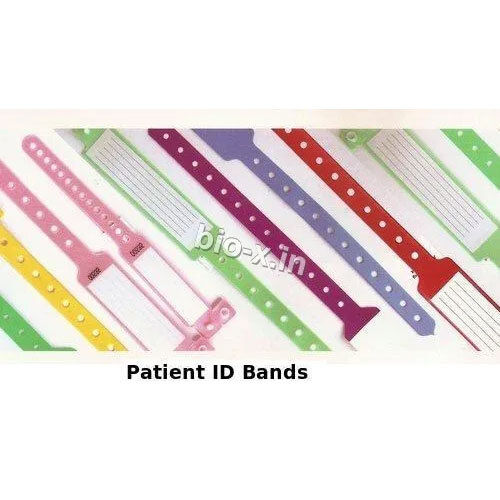Understanding the Technological Advancements Behind the Patient Identification Band
Understanding the Technological Advancements Behind the Patient Identification Band
Blog Article
Exploring the Various Sorts Of Patient Identification Band Used in Medical Facilities
In the complex world of medical care, the critical function of Patient Identification bands typically goes unnoticed. These bands, differing from basic paper wristbands to sophisticated RFID bands, form the foundation of Patient safety and security protocols, making sure accuracy in Patient Identification. Yet, the huge variety of these bands, each with its distinct benefits and restrictions, is frequently neglected. As we navigate via this topic, one may gain understanding into the subtle intricacies and important importance of such bands in medical centers.
Understanding the Significance of Patient Identification Bands
While they might appear like simple accessories, Patient Identification bands play an important duty in clinical facilities. These bands serve as a vital device for validating Patient identity, avoiding clinical mistakes connected to misidentification. Patient Identification bands additionally help in enhancing administrative jobs, guaranteeing exact record-keeping and billing.
Typical Paper Wristbands: Their Use and Limitations
Traditional paper wristbands have actually been a staple in Patient Identification across various clinical centers. While their use is widespread, they harbor specific restrictions that might affect their efficiency in Patient monitoring. This section will concentrate on the extent of their application and the integral downsides linked with their usage.
Paper Wristbands: Use Scope
In the realm of Patient Identification, paper wristbands have actually long held an important duty. These bands are generally made use of in outpatient settings, where the Patient's remain is temporary. Regardless of improvements in innovation, the simple paper wristband remains a cost-effective and reputable remedy for Patient Identification in different medical care circumstances.
Limitations of Paper Wristbands
In spite of their widespread use, paper wristbands are not without their drawbacks. In addition, paper wristbands frequently do not have the technical capabilities of more contemporary options, such as barcoding or RFID chips, limiting their capability to simply presenting created information. Paper wristbands can create discomfort or skin irritation to some patients, particularly when worn for prolonged durations.
Barcoded Wristbands: Developments in Patient Identification
While Patient Identification has actually long been a vital facet of medical care, the development of barcoded wristbands represents a significant jump forward. These bands utilize the simplicity of barcoding innovation, enabling for Patient details to be swiftly checked and accessed. They improve the rate and accuracy of Patient Identification, decreasing the threat of medical errors related to misidentification.
Superhigh Frequency Identification (RFID) Bands: a Step Towards Futuristic Health Care
The advancement of Patient Identification bands has actually brought regarding the appearance of Radio Regularity Identification (RFID) Bands (patient identification band). These ingenious gadgets present essential benefits for healthcare facilities, providing a much more effective and highly advanced ways of Patient Identification. The execution of RFID in healthcare is a substantial action in the direction of a much more futuristic technique to Patient monitoring and security
Recognizing RFID Bands

RFID Bands: Secret Advantages
Mostly, these bands enhance Patient safety and security by supplying accurate, rapid Identification, therefore lowering medical mistakes. RFID bands can save a large amount of Patient information, including clinical background and allergies, making it possible for personalized treatment. Generally, RFID bands represent a significant improvement in Patient Identification modern technology, profiting both individuals and medical care providers.
Applying RFID in Health Care
These bands offer a smooth method to track and recognize patients, guaranteeing their security and enhancing efficiency in treatment procedures. RFID bands reduce medical mistakes by supplying accurate Patient Identification, which is vital in preventing misdiagnosis or incorrect medicine management. Therefore, the implementation of RFID bands is a considerable step towards boosting Patient security and healthcare delivery.

Color-Coded Wristbands: Aiding in Quick and Accurate Medical Diagnosis
In the busy environment of a medical center, color-coded wristbands have actually emerged as essential tools for swift and accurate Identification of an individual's clinical problem. These wristbands, worn by clients, lug details shades that correspond to different clinical problems or conditions. This system is made to provide immediate visual signs to healthcare companies, boosting Patient safety and security and care high quality.
Methods for Efficient Execution and Monitoring of Patient ID Bands
Attaining optimal use of Patient Identification bands necessitates a well-structured technique for their implementation and administration. Patient education is additionally vital; clients have to comprehend the objective of the bands and the need for their consistent wear. It's necessary to have a backup strategy in location, such as barcode scanning or biometrics, to ensure that Patient Identification is never ever jeopardized.
Conclusion
Patient Identification bands are crucial in medical facilities to make sure security and precision. Traditional paper, barcoded, RFID, and color-coded wristbands each hold special benefits, ranging from cost-effectiveness to advanced information see this here storage space you can try here and immediate medical notifies. Efficient implementation and administration of these bands can significantly decrease medical errors, increase effectiveness, and enhance overall Patient care. Therefore, understanding and utilizing these Identification devices is critical for keeping high requirements in medical care.
These bands, varying from basic paper wristbands to advanced RFID bands, create the foundation of Patient security methods, guaranteeing precision in Patient Identification.The evolution of Patient Identification bands has actually brought regarding the introduction of Radio Regularity Identification (RFID) Bands. On the whole, RFID bands represent a substantial advancement in Patient Identification technology, profiting both people and medical care providers.
RFID bands decrease clinical errors by providing accurate Patient Identification, which is critical in preventing misdiagnosis or wrong medication administration. Patient education is also crucial; patients need to understand the function of the bands and the need for their constant wear.
Report this page